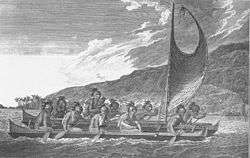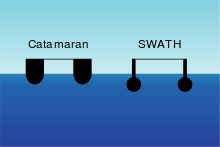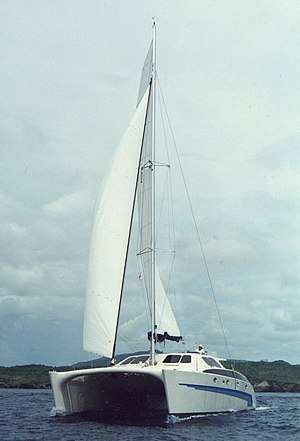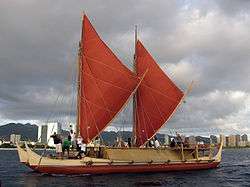Multihull
A multihull is a ship or boat with more than one hull, whereas a vessel with a single hull is a monohull.

Multihull ships can be classified by the number of hulls, by their arrangement and by their shapes and sizes.[1]
Multihull history

The first multihull vessels were Austronesian canoes. The builders hollowed out logs to make canoes and stabilized them by attaching outriggers to prevent them from capsizing. This led in due course to the proa, catamaran, and trimaran.
In Polynesian terminology the catamaran is a pair of Vaka held together by Aka, whereas the trimaran is a central Vaka, with Ama on each side, attached by Aka.[2] Catamarans and trimarans share the same terminology.[3]
- Ama[2] − The ama is the outrigger hull, attached to add stability.
- Aka[2] − The aka connects the vaka to the ama. In Hawaiian, this is called the iako (crossarm).
- Vaka[2] − The vaka is the main canoe-like hull.
Modern pioneers of multihull design include James Wharram (UK), Derek Kelsall (UK), Tom Lack (UK), Lock Crowther (Aust), Hedly Nicol (Aust), Malcolm Tennant (NZ), Jim Brown (USA), Arthur Piver (USA), Chris White (US), Ian Farrier (NZ), LOMOcean (NZ), and Dick Newick (USA).
Multihull types
The vast majority of multihull sailboats are catamarans. Trimarans are less common, and proas are virtually unknown outside the South Pacific.
Outrigger canoe & proa
An outrigger canoe is a canoe with a slender outrigger ("ama") attached by two or more struts ("akas"). This craft will normally be propelled by paddles. If the craft has a sail, it is known as a proa. While canoes and proas both derive stability from the outrigger, the proa has the greater need of the outrigger to counter the heeling effect of the sail. The difficulty with the proa is that the outrigger must be on the lee side to be effective, which means that a change of tack will need the sail to be rearranged.
Catamaran
A catamaran is a vessel with twin hulls. Commercial catamarans began in 17th century England. Separate attempts at steam-powered catamarans were carried out by the middle of the 20th century. However, success required better materials and more developed hydrodynamic technologies. During the second half of the 20th century catamaran designs flourished. Nowadays, catamarans are used as racing, sailing, tourist and fishing boats. Cruising catamarans are becoming important in the holiday charter market. Some 70% of fast passenger RoRo ferries are catamarans.
The hulls of a catamaran are typically connected by a bridgedeck, although some simpler cruising catamarans[4] simply have a trampoline stretched between the crossbeams (or "akas").[5] Small beachable catamarans, such as the Hobie Cat, also have only a trampoline between the hulls.
Catamarans have no ballast and their stability is derived from the width between the hulls. The distance between hulls is called the "transverse clearance", and the greater this distance, the more stable the catamaran will be.
A catamaran's hulls are slim, although they may flare above the waterline to give reserve buoyancy.[6] Catamarans are prone to "slamming", an unpleasant phenomenon where the waves slam against the underside of the bridge deck. The distance between the design waterplane and the bottom of the bridgedeck is called the "vertical clearance"; and the greater this distance, the less slamming will be encountered.[7] Although a large vertical clearance normally increases a catamaran's seaworthiness, the designer must take care not to raise the overall CoG too much.
Trimaran
.jpg)
A trimaran is a vessel with three hulls. Unlike a catamaran where the hulls are mirror-images of each other, a trimaran is rather like a monohull with two slim outriggers.[8] A trimaran has less accommodation space than a catamaran, but may be capable of even faster speeds.
The trimaran has the widest range of interactions of wave systems generated by hulls at speed. The interactions can be favorable or unfavorable, depending on relative hull arrangement and speed. No authentic trimarans exist. Model test results and corresponding simulations provide estimates on the power of the full-scale ships. The calculations show possible advantages in a defined band of relative speeds.
A new type of super-fast vessel, the wave-piercing trimaran (WPT) is known as an air-born unloaded (up to 25% of displacement) vessel, that can achieve twice the speed with a relative power.
Some trimaran configurations use the outlying hulls to enhance stability and allow for shallow draft, examples include the experimental ship RV Triton[9] and the Independence class of littoral combat ships (US).[10]
Four and five hulls
Some multihulls with four (quadrimaran) or five (pentamaran) hulls have been proposed; few have been built.[11] A Swiss entrepreneur is attempting to raise €25 million[12] to build a sail-driven quadrimaran that would use solar power to scoop plastic from the ocean; the project is scheduled for launch in 2020.[13] A French manufacturer, Tera-4, produces motor quadrimarans which use aerodynamic lift between the four hulls to promote planing and reduce power consumption.[14]
Design concepts for vessels with two pair of outriggers have been referred to as pentamarans. The design concept comprises a narrow, long hull that cuts through waves. The outriggers then provide the stability that such a narrow hull needs. While the aft sponsons act as trimaran sponsons do, the front sponsons do not touch the water normally; only if the ship rolls to one side do they provide added buoyancy to correct the roll.[15][16] BMT Group, a shipbuilding and engineering company in the UK, has proposed a fast cargo ship and a yacht using this kind of hull.[17][18]
SWATH multihulls

Multihull designs may have hull beams that are slimmer at the water surface ("waterplane") than underwater. This arrangement allows good wave-piercing, while keeping a buoyant hydrodynamic hull beneath the waterplane. In a catamaran configuration this is called a small waterplane area twin hull, or SWATH.[19] While SWATHs are stable in rough seas, they have the drawbacks, compared with other catamarans, of having a deeper draft, being more sensitive to loading, and requiring more power because of their higher underwater surface areas.[20] Triple-hull configurations of small waterplane area craft had been studied, but not built, as of 2008.[21]
Characteristics
Multihulls differ significantly from monohulls in a number of ways:
Physical
Multihulls have a broader variety of hull and payload geometries. Compared to a monohull, they have a relatively large beam, deck area (upper and inner), above-water capacity, shallower draft (allowing operation in shallower water) but a limited payload.
Stability
Early Austronesians discovered that round logs tied together into a raft were more stable than a single log. Hollowing out the logs further increased buoyancy and payload. Separating two logs by a pair of cross-members (or "akas") further increased stability. Spanning the intervening distance with a platform provides space for accommodation.
Compared to monohulls, multihulls are much less prone to heeling (tilt); a sailing catamaran will rarely heel more than 5° whereas a monohull will frequently heel to 45°. This is particularly noticeable when running the wind; a monohull will roll incessantly, while a catamaran will remain upright. A catamaran's stable motion reduces seasickness and tiredness of the crew, making it safer and more suitable for family cruising. The stability also allows more efficient solar energy collection and radar operation. However, shorter multihulls may be more prone towards an uncomfortable motion called hobby horsing, especially when lightly loaded.
Being heavier (because of its ballast), a monohull's momentum will temporarily maintain progress if the wind drops, while a (lighter) multihull has less momentum and may be prone to going "in irons" when going about. (Multihulls need to keep the jib "aback" to complete the turn. However, multihull skippers will frequently choose to "gybe" instead, as gybing is much less of an event in a multihull than in a monohull. Multihulls "ghost" well under sail as they respond readily in light airs.
Ballast

From the earliest times, monohulls (whether or not fitted with sails) were stabilized by carrying ballast (such as rocks) in the bilges; and all modern monohull yachts and ships still rely on ballast for stability. Naval architects arrange the vessel's centre of gravity to be well below the hull's metacenter. The low centre of gravity acts as a counterweight as the craft heels around its centre of buoyancy; that is, as a monohull heels, its ballast operates to restore it to its upright position.
By contrast, a multihull's stability is derived from its width, and modern multihulls are much wider than earlier designs, with the beam sometimes more than half the LOA. Should the weather hull lift from the water, the weight of the vessel will seek to restore the multihull to its normal position. However, unlike a monohull, a multihull has a "point of no return" which will lead to the vessel becoming inverted. A catamaran dinghy may be righted by its crew, but a large cruising cat will normally remain inverted unless it can be craned upright.
A catamaran that is being pressed too hard may "pitchhole (capsize)", a disastrous event whereby the lee bow (downwind bow) digs into the water and trips, followed by the stern rising and the entire vessel somersaulting.
Safety
Having no ballast, multihulls that become holed or inverted have a high rate of survivability; water-tight bulkheads should prevent sinking if the hulls fail. Catamarans may have increased reliability because most have an engine in each hulls. Whereas capsized monohulls typically right themselves, capsized multihulls remain inverted. Large multihulls may have escape hatches in the hulls or bridgedeck.
Performance
Having a low displacement,[22] and long, narrow hulls, a multihull typically produces very small bow waves and wakes, a consequence of a favorable Froude number.[23][24][25] Vessels with beamy hulls (typically monohulls) normally create a large bow wave and wake. Such a vessel is limited by its "hull speed", being unable to "climb over" its bow wave unless it changes from displacement mode to planing mode. Vessels with slim hulls (typically multihulls) will normally create no appreciable bow wave to limit their progress.
In 1978, 101 years after catamarans like Amaryllis were banned from yacht racing[26] they returned to the sport. This started with the victory of the trimaran Olympus Photo, skippered by Mike Birch in the first Route du Rhum. Thereafter, no open ocean race was won by a monohull. Winning times dropped by 70%, since 1978. Olympus Photo's 23-day 6 hr 58' 35" success dropped to Gitana 11's 7d 17h 19'6", in 2006. Around 2016 the first large wind driven foil-borne racing catamarans were built. These cats rise onto foils and T-foiled rudders only at higher speeds.
Sailing multihulls and workboats
.jpg)
The increasing popularity of catamaran since the 1960s is down to the added space, speed, shallow draft, and lack of heeling underway. The stability of a multihull makes sailing much less tiring for the crew, and is particularly suitable for families. Having no need for ballast for stability, multihulls are much lighter than monohull sailboats; but a multihull's fine hull sections mean that one must take care not to overload the vessel. Powerboats catamarans are increasingly used for racing, cruising and as workboats and fishing boats. Speed, the stable working platform, safety, and added space are the prime advantages for power cats.
"The weight of a multihull, of this length, is probably not much more than half the weight of a monohull of the same length and it can be sailed with less crew effort."[27]
Racing catamarans and trimarans are popular in France, New Zealand and Australia. Cruising cats are commonest in the Caribbean and Mediterranean (where they form the bulk of the charter business) and Australia. Multihulls are less common in the US, perhaps because their increased beam require wider dock/slips. Smaller multihulls may be collapsible and trailerable, and thus suitable for daybooks and racers. Until the 1960s most multihull sailboats (except for beach cats) were built either by their owners or by boat builders; since then companies have been selling mass-produced boats, of which there are more than 150 models.[28]
Small sailing catamarans are also called beach catamarans. The Malibu Outrigger is one of the first beach launched multihull sailboat (1950). The most recognised racing classes are the Hobie Cat 14, Formula 18 cats, A-cats, the current Olympic Nacra 17, the former Olympic multihull Tornado and New Zealand's Weta trimaran.
Mega or super catamarans are those over 60 feet in length. These often receive substantial customisation following the request of the owner. Builders include Corsair Marine (mid-sized trimarans) and HanseYachts' Privilège brand (large catamarans). The largest manufacturer of large multihulls is Fountaine-Pajot in France.
Powerboats range from small single pilot Formula 1s to large multi-engined or gas turbined power boats that are used in off-shore racing and employ 2 to 4 pilots.
See also
Notes
- Dubrovsky, V (2004) Ships with Outriggers, Backbone Publishing Co, ISBN 0-9742019-0-1
- "A primer on proas". Retrieved 2007-10-30.
- "The Tridarka Raider". Archived from the original on 2007-10-20. Retrieved 2007-10-30.
- Such as some Wharram designs
- Dubrovsky, V, Laykhovitsky, A (2001) Multi Hull Ships. Backbone Publishing Co. ISBN 97809644311-2-6
- As in all the Catalac designs
- Tuck, E. O.; Lazauskas, L. (June 11, 1998), "Optimum Hull Spacing of a Family of Multihulls" (PDF), Applied Mathematics Department, The University of Adelaide: 38, retrieved 2016-01-15
- Note: More precisely, the term trimaran is used for a ship or boat with three identical hulls of traditional shape.
- "Northern Patrol Vessel ACV Triton Fact Sheet Australian Customs Service" (PDF).
- "US Navy Fact File: Littoral Combat Ship Class – LCS". US Navy. Retrieved 14 March 2015.
- William Hockberger (2007). "Quadrimaran Ferries - High Speed with Shallow Draft". Transportation Research Board Annual Meeting. doi:10.3141/2033-01. Cite journal requires
|journal=(help) - Müller, Kristina (January 3, 2018). "Ein Quadrimaran für saubere Meere". Yacht Magazin (in German). Retrieved 2019-03-22.
- Staff (2018-04-11). "Mit einem Quadrimaran will Schweizer Plastik aus Meer holen". Blick (in German). Retrieved 2019-03-22.
- Editors (April 10, 2017). "Tera-4 signe la vente de son tout premier quadrimaran". ActuNautique.com (in French). Retrieved 2019-03-22.CS1 maint: extra text: authors list (link)
- Editors (June 21, 1999). "Five Hulls Make Ships Faster". www.marinetalk.com. Retrieved 2019-03-09.CS1 maint: extra text: authors list (link)
- Editors (December 11, 2001). "In the ocean fast lane". BBC News. Retrieved 2019-03-09.CS1 maint: extra text: authors list (link)
- Martin, Jack (September 4, 2008). "Project Veloce - 130 metre 40 knot Pentamaran Super Yacht". newatlas.com. Retrieved 2019-03-09.
- Editors (December 7, 2005). "Ships power into faster future". BBC News. Retrieved 2019-03-09.CS1 maint: extra text: authors list (link)
- Misra, Suresh Chandra (2015). Design Principles of Ships and Marine Structures. CRC Press. p. 474. ISBN 9781482254471.
- Kaharl, Victoria (May 4, 1986). "Ships on Stilts". chicagotribune.com. Retrieved 2019-03-25.
- Dubrovsky, V. (2008-08-22). "An example of a triple-hull SWA ship of ultimate longitudinal shift (hull structure mass estimation)". Ships and Offshore Structures. 3 (3): 263–265. doi:10.1080/17445300801989014. ISSN 1744-5302.
- Whereas a monohull's "tonnage" (a measure of volume) will usually be similar to its mass, a multihull's displacement will typically be half its tonnage.
- The Froude number of any hull is calculated by where u is the relative flow velocity between the sea and ship, g is in particular the acceleration due to gravity, and L is the length of the ship at the water line level, or Lwl in some notations. It is an important parameter with respect to the ship's drag, or resistance, especially in terms of wave making resistance.
- J.W., Park; J.J., Kim; D.S., Kong (2001), Wu, You-Sheng; Zhou, Guo-Jun; Cui, Wei-Cheng (eds.), Numerical computation of ship's effective wake and its validation in large cavitation tunnel, Practical Design of Ships and Other Floating Structures: Eighth International Symposium - PRADS 2001, 1, Elsevier, p. 1422, ISBN 9780080539355
- Instructors. "Resistance and powering of ships" (PDF). US Naval Academy. pp. 7–9.
- L. Francis Herreshoff. "The Spirit of the Times, November 24, 1877 (reprint)". Marine Publishing Co., Camden, Maine. Archived from the original on 2008-01-24.
- Jim Howard; Charles J. Doane (2000). Handbook of offshore cruising: The Dream and Reality of Modern Ocean Cruising. ISBN 9781574090932.
- "Sailor's Multihull Guide" - 3rd edition
References and Bibliography
- Jim Howard, Charles J. Doane (2000). Handbook of offshore cruising: The Dream and Reality of Modern Ocean Cruising. Sheridan House, Inc. p. 280. ISBN 1-57409-093-3.
- C. A. Marchaj (2000). Aero-Hydrodynamics of Sailing. Tiller Publishing. ISBN 1-888671-18-1.
- C. A. Marchaj. Sail Performance. McGraw Hill. p. 400. ISBN 0-07-141310-3.
- C. A. Marchaj. Seaworthiness:The Forgotten Factor. Tiller Publishing. p. 372. ISBN 1-888671-09-2.
- Gavin le Sueur. Multihull Seamanship. John Wiley & Sons. p. 144. ISBN 1-898660-31-X.
- Harvey, Derek, Multihulls for Cruising and Racing, Adlard Coles, London 1990, ISBN 0-7136-6414-2
External links
| Wikimedia Commons has media related to Multihulls. |
- The Multihull Offshore Cruising & Racing Association
- The UK Catamaran Racing Association
- The Multihull Yacht Club of Queensland (Australia)
- Multihull Boatbuilding Information / Community
- Articles and news on multihulls, profiles of boats, designers, yards, etc.
- Multihulls designer & builder
- International Sailing Federation
- The multihulls reference magazine
- The multihulls reference magazine (Australia)


.jpg)